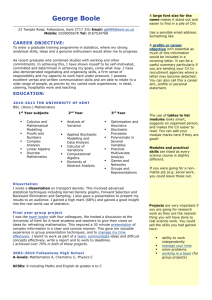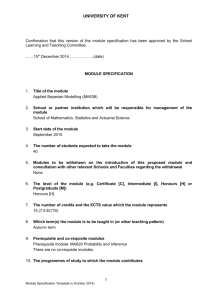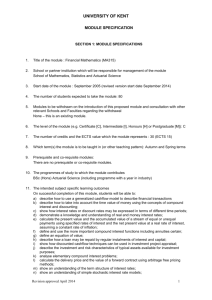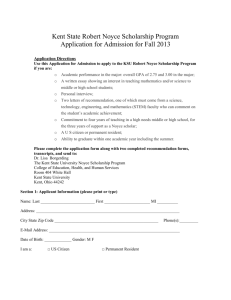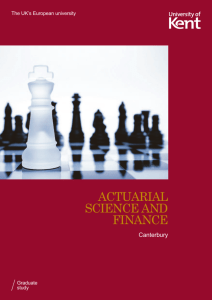UNIVERSITY OF KENT
advertisement
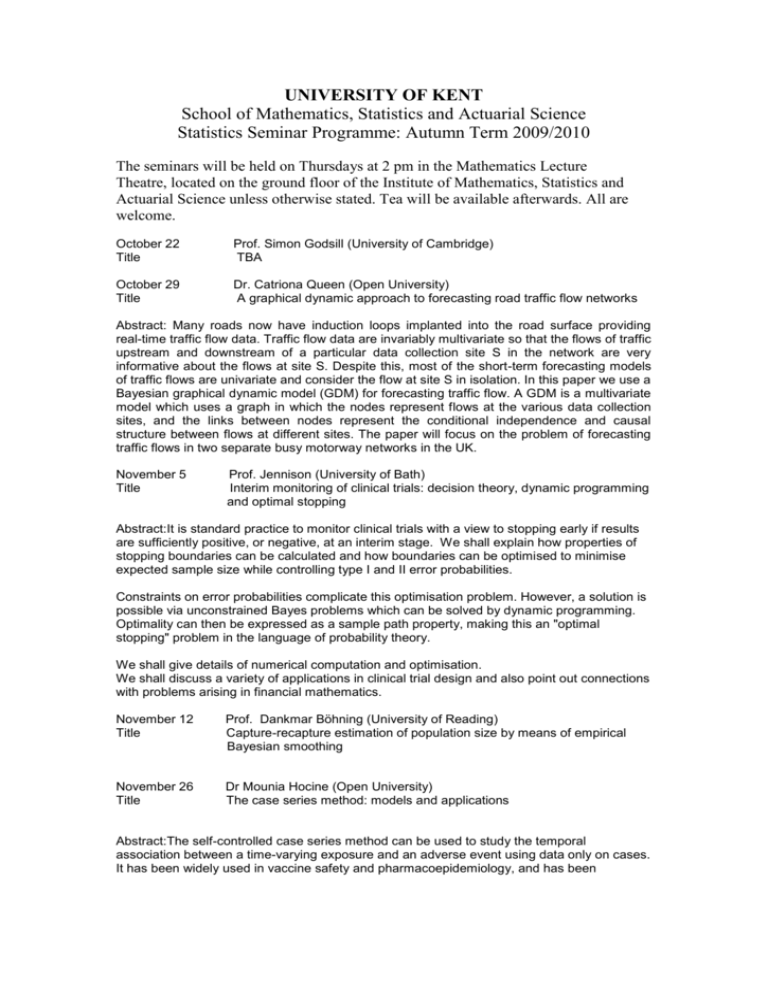
UNIVERSITY OF KENT School of Mathematics, Statistics and Actuarial Science Statistics Seminar Programme: Autumn Term 2009/2010 The seminars will be held on Thursdays at 2 pm in the Mathematics Lecture Theatre, located on the ground floor of the Institute of Mathematics, Statistics and Actuarial Science unless otherwise stated. Tea will be available afterwards. All are welcome. October 22 Title Prof. Simon Godsill (University of Cambridge) TBA October 29 Title Dr. Catriona Queen (Open University) A graphical dynamic approach to forecasting road traffic flow networks Abstract: Many roads now have induction loops implanted into the road surface providing real-time traffic flow data. Traffic flow data are invariably multivariate so that the flows of traffic upstream and downstream of a particular data collection site S in the network are very informative about the flows at site S. Despite this, most of the short-term forecasting models of traffic flows are univariate and consider the flow at site S in isolation. In this paper we use a Bayesian graphical dynamic model (GDM) for forecasting traffic flow. A GDM is a multivariate model which uses a graph in which the nodes represent flows at the various data collection sites, and the links between nodes represent the conditional independence and causal structure between flows at different sites. The paper will focus on the problem of forecasting traffic flows in two separate busy motorway networks in the UK. November 5 Title Prof. Jennison (University of Bath) Interim monitoring of clinical trials: decision theory, dynamic programming and optimal stopping Abstract:It is standard practice to monitor clinical trials with a view to stopping early if results are sufficiently positive, or negative, at an interim stage. We shall explain how properties of stopping boundaries can be calculated and how boundaries can be optimised to minimise expected sample size while controlling type I and II error probabilities. Constraints on error probabilities complicate this optimisation problem. However, a solution is possible via unconstrained Bayes problems which can be solved by dynamic programming. Optimality can then be expressed as a sample path property, making this an "optimal stopping" problem in the language of probability theory. We shall give details of numerical computation and optimisation. We shall discuss a variety of applications in clinical trial design and also point out connections with problems arising in financial mathematics. November 12 Title Prof. Dankmar Böhning (University of Reading) Capture-recapture estimation of population size by means of empirical Bayesian smoothing November 26 Title Dr Mounia Hocine (Open University) The case series method: models and applications Abstract:The self-controlled case series method can be used to study the temporal association between a time-varying exposure and an adverse event using data only on cases. It has been widely used in vaccine safety and pharmacoepidemiology, and has been extended recently for use in pharmacovigilance. The key advantages are that it has high efficiency relative to the cohort method and that it is self-controlled: fixed confounders, such as sex, location, and genetic factors are controlled for implicitly. Recent models and applications will be presented. December 3 Title Prof. Gareth Roberts (University of Warwick) Bayesian non-parametric analysis of diffusions December 10 Title Dr Kostas Kalogeropoulos (London School of Economics) Diffusion models for physiological processes. December 17 Title Prof. Jonathan Forster (University of Southampton) TBA Further information is available from Xue Wang, School of Mathematics, Statistics and Actuarial Science, Cornwallis Building, University of Kent, Canterbury, Kent CT2 7NF (Tel: 01227 823796; Email: X.Wang@kent.ac.uk) or Web:http://www.kent.ac.uk/ims/seminars/index.html#statistics
